January 2, 2019
I’m breathless in Mexico City, and that’s only partly because I’m at 7200 feet, 19 degrees north of the equator, and about 1600 miles from Bloomington.
My physical state is partly due to what we’ve seen and done the last day and a half. Carolyn has had a long fascination with pre-Columbian art, and our library has a nice sprinkling of coffee table books accumulated over the years from exhibits at the Art Institute, but they pale before what we saw today at the National Archeological Museum of Mexico, and the remnants of the pre-Conquest ruins in Mexico City.
David Hoyt thought the museum was equivalent to the Louvre of the Western Hemisphere (he’s a Francophile), but that’s not quite accurate. The Louvre not only has treasurers of French painting (Liberty storming the Barricades), but European as well (Mona Lisa anyone), as well as Nike and other European paintings and sculptures—at a minimum.
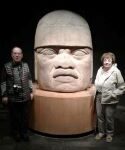
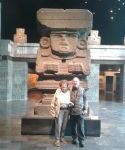 The National Archeological Museum of Mexico is primarily Meso-American in focus, and that almost is exclusively what is now Mexico. And what treasurers it has! A 20 ton head from the Olmec period (bear in mind Meso-America awaited Europeans to introduce metal tools. Southern Mexico had gold, but most of the area used obsidian for all purposes, including knives to kill and extract hearts for sacrifices), huge pyramids and temples and tombs (we saw the excavations of one in Zocalo, the central historic district of Mexico City), and huge stone monoliths celebrating or pacifying the gods—water, war, corn, and maize. The latter really struck home for me—the region seems to have had abundant crops, far different than Europe. It was the New World the contributed squash and beans and corn (flour and tortillas), and maguey (the Century plant, good for everything from soap to booze), and chilis—can you imagine Thai food before the European discovery of the New World? Perhaps the two most stunning rooms in the museum were dedicated to the Aztec (Mexica) and the Mayans. The Mayans whose crowning achievements are in the Yucatan were a little earlier than the Aztecs. Interesting to me were some of the similarities with Cahokia Mounds, our Illinois counterparts, which indicated to me that the culture and trade stretch through the Americas.
The National Archeological Museum of Mexico is primarily Meso-American in focus, and that almost is exclusively what is now Mexico. And what treasurers it has! A 20 ton head from the Olmec period (bear in mind Meso-America awaited Europeans to introduce metal tools. Southern Mexico had gold, but most of the area used obsidian for all purposes, including knives to kill and extract hearts for sacrifices), huge pyramids and temples and tombs (we saw the excavations of one in Zocalo, the central historic district of Mexico City), and huge stone monoliths celebrating or pacifying the gods—water, war, corn, and maize. The latter really struck home for me—the region seems to have had abundant crops, far different than Europe. It was the New World the contributed squash and beans and corn (flour and tortillas), and maguey (the Century plant, good for everything from soap to booze), and chilis—can you imagine Thai food before the European discovery of the New World? Perhaps the two most stunning rooms in the museum were dedicated to the Aztec (Mexica) and the Mayans. The Mayans whose crowning achievements are in the Yucatan were a little earlier than the Aztecs. Interesting to me were some of the similarities with Cahokia Mounds, our Illinois counterparts, which indicated to me that the culture and trade stretch through the Americas.
The Spanish, of course, led by Cortes and an army that our guide insists were dregs from the prisons, arrived in 1521 determined to find gold and treasures, and dethroned (and decapitated) Montezuma and two successors, a period known as the Conquest, which initiated almost 300 years of “Nuevo Espana”, Spain’s prized possession in the new world, to which Spain brought “civilization”—the Inquisition, the Catholic Church, and the Spanish language, among other legacies.
The rest of our day was in the Historic Center, which had been the Aztec 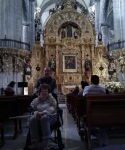 capital, destroyed by the Spanish, who erected their colonial capital on the site. That included a monstrous cathedral (of course), the largest in Latin America. Built in the 18th century, it’s in the baroque style I greatly enjoy, with an addition in a local style named for the architects that is even more over the top. Our guide said that every time there’s an excavation, something new is found. The famous Aztec calendar (did you know it’s about 6 feet in
capital, destroyed by the Spanish, who erected their colonial capital on the site. That included a monstrous cathedral (of course), the largest in Latin America. Built in the 18th century, it’s in the baroque style I greatly enjoy, with an addition in a local style named for the architects that is even more over the top. Our guide said that every time there’s an excavation, something new is found. The famous Aztec calendar (did you know it’s about 6 feet in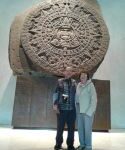 diameter?) being one item, and Temple Mayor, the chief Aztec temple, being another now under excavation. Indeed, looking at the map of what’s known, less that 5%s of the historic sites have been excavated.
diameter?) being one item, and Temple Mayor, the chief Aztec temple, being another now under excavation. Indeed, looking at the map of what’s known, less that 5%s of the historic sites have been excavated.
We also visited the 18th century Palace Nacional, now the president’s palace, that had been the home of the 60 or so Spanish Viceroys. The building houses spectacular murals by Diego Rivera, encapsulating his (mostly socialist/Marxist) view of history—when Rockefeller commissioned him to draw a mural in the Rockefeller center it had likenesses of Karl Marx; the Standard Oil baron paid his friend Rivera, but tore the mural down. The sketches included Mr.Polk’s war (1846-7) and the bizarre interlude when the Archduke Maximillian of Austria was offered the Mexican throne in 1864 and lasted three years before he was deposed and executed, leaving behind the furniture in Chapultepec Castle that I’ll tell more about tomorrow.
January 3, 2019
Mr. Polk’s War, which could really be called “The war of Yankee aggression”—though “Southern aggression” to expand slavery might be more appropriate.
We’re staying near Chapultepec Hill, which means “Grasshopper Hill”—and yes, grasshopper snacks are available. They’re not bad with lemon and salt. Read that as not necessarily good. Or maybe an acquired taste. Chapultepec was one of the major battle sites in the Mexican-American War, one which the Mexicans have naturally a different spin on than we do. About a third of Mexican territory was wrested away—including California, Texas (which had declared itself independent of Mexico, that being one of the casus belli) and much of the American Southwest, for something like 15 million pesos—and a short war. I remember reading something about it in the new biography of Grant, who was one of the many Civil War participants who cut his military teeth on the battles here, including Chapultepec Hill. It was one of the major battles because it is a hill above the city (the city itself is 7200 feet high, with 10-12000 foot mountains, some volcanic, nearby. The city, once an island in a lake, has twin problems—earthquake activity (an 8.1 quake 33 years ago severely damaged the cathedral) and the marshy bottom means that parts of the historic center are sinking.
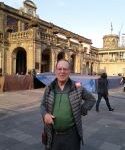 Roughly, the story we were told is that Chapultepec housed the military academy, and General Santa Ana told his army to stand and fight, then fled with their bullets. The 100 academy cadets though, stood their ground and perished. The last 9 became hero-martyrs with a large monument to los nueve ninos in the park.
Roughly, the story we were told is that Chapultepec housed the military academy, and General Santa Ana told his army to stand and fight, then fled with their bullets. The 100 academy cadets though, stood their ground and perished. The last 9 became hero-martyrs with a large monument to los nueve ninos in the park.
The castle served duty for the Archduke, who was invited to assume a Mexican throne and put an end to chaos, supported by a French army. Maximilian brought over his own furniture from Europe at the cost of bankrupting the Mexican treasury, which, in part, led to his downfall and execution. The sumptuous furniture remains as a major attraction of what is now the National Museum of History. Among the other items I saw were the banner of Cortes (the Virgin Mary) and the banner of one of the founders of independent Mexico, a priest who rallied the troops with the banner of the Virgin of Guadalupe, an apparition of the Virgin that is one of the pillars of Mexican Catholicism.
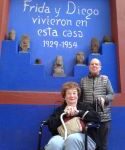 We spent most of the day in the 20th century, in the artistic, political, and intimate triangle of artists Diego Rivera, his sometime wife Frida Kahlo, and the political refugee (friend of Diego, lover of Frida) Leon Trotsky. Rivera went to Russia to study, flirted with Communism, and the circles in which he and Frida traveled steered from socialism to communism. Frida’s bedroom, where she died in the early 1950s had portraits of Mao, Lenin, and Stalin. Trotsky got Rivera to get him admitted to Mexico (he and Stalin broke after 1924;
We spent most of the day in the 20th century, in the artistic, political, and intimate triangle of artists Diego Rivera, his sometime wife Frida Kahlo, and the political refugee (friend of Diego, lover of Frida) Leon Trotsky. Rivera went to Russia to study, flirted with Communism, and the circles in which he and Frida traveled steered from socialism to communism. Frida’s bedroom, where she died in the early 1950s had portraits of Mao, Lenin, and Stalin. Trotsky got Rivera to get him admitted to Mexico (he and Stalin broke after 1924;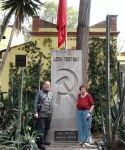 Trotsky spent time in Kazakstan, Turkey, France, and Norway before living in Mexico. Rivera asked him to leave the house when he had an affair with Frida (though they stayed friends) but built a house that was an armed camp with live in guards (some of them Mexican police). He survived one gang attack, but a Catalan Stalinist got access to Trotsky and stabbed him with a pick axe. He is buried in the compound.
Trotsky spent time in Kazakstan, Turkey, France, and Norway before living in Mexico. Rivera asked him to leave the house when he had an affair with Frida (though they stayed friends) but built a house that was an armed camp with live in guards (some of them Mexican police). He survived one gang attack, but a Catalan Stalinist got access to Trotsky and stabbed him with a pick axe. He is buried in the compound.
Frida’s house was mobbed—known as the casa azul, the blue house, it (and Trotsky and Rivera’s house/studio are all in an area of town called Coyote, which had been a small colonial village until overrun by the growth of Mexico City. Before we left, I was reading Howard Kline’s, The United States and Mexico, a 1940s classic; at the time, the population of Mexico was 25 million. Today that’s yje population of Mexico City. The neighborhood is still pretty quaint, with some homes including the “Casa Cortes” dating from the conquest. Artists—and tourists—hang out there.